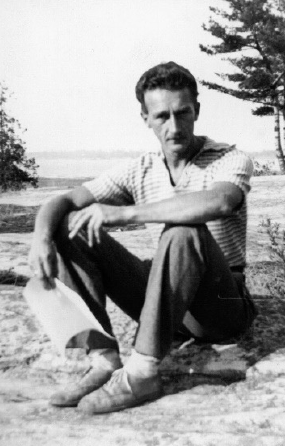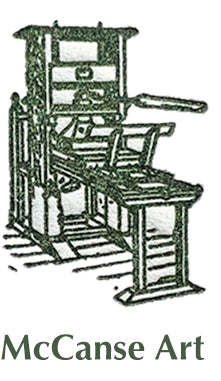Nicholas Hornyansky
Nicholas Hornyansky was born in Budapest, Hungary in 1886. At the age of 12, he began working at his father’s printing office as a colour mixer. A few years later, at 16, Hornyansky became a co-exhibitor at the Grand Salon in Budapest. In the following years, he began his formal arts education at the Academy of Fine Arts in Budapest, where he studied portraiture under Vilmos Aba-Novak.

After graduating, Hornyansky continued his studies throughout Europe, taking classes in Austria, Germany, France, Holland, and Belgium. In 1919, he went to Antwerp to study under Franz Hens. During his time in Antwerp, Hornyansky was introduced to etching. Hornyansky went on to Paris, where he worked as an apprentice in the esteemed ‘taille doucier’ workshop under Jean Procabeouf. Here, Hornyansky learned the single-pull aquatint technique, a print method which originated in Paris. During his time studying in Europe, he commissioned portraits for several notable figures, including Cardinal Mercier of Belgium, Lord Newton of England, and several members of the Belgian and Dutch nobilities. In 1927, he married cellist Joyce Sands, with whom he had two children.
In 1929, Hornyansky and Sands immigrated to Toronto, where he quickly integrated himself into the Canadian printmaking community. Hornyansky began exhibiting in Toronto and elsewhere across North America, quickly earning himself a reputation for his aquatints. In 1930, Hornyansky became a member of the Society of Canadian Painter-Etchers and Engravers (CPE). Between 1931 and 1942, Hornyansky began exhibiting more actively, showing his work with the Spring Salons and the Art Association of Montreal, the Royal Canadian Academy of Arts (RCA), and the Ontario Society of Artists (OSA). During this time, Hornyansky was also affiliated with the Canadian Society of Graphic Arts. He traveled throughout Canada during these years, spending significant time etching and painting in British Columbia, Ontario, and the Maritimes. The influence of his travels are depicted in his vast collection of landscape and streetscape etchings of these regions.
As he began to exhibit more frequently and broadly, Hornyansky’s career developed internationally. In both 1932 and 1933, Hornyansky won the “50 Colour Prints of the Year” award, an international award given out by the American Federation of Artists; in 1933, he became a member of the American Color Print Society. Furthermore, his print “Closing Time” was the first Canadian print to enter the Permanent National Collection of Prints in the Library of Congress in Washington. In 1936, Hornyansky exhibited at the Carnegie World Tour, and in the following years, at the New York World’s Fair, the South American Tour and the USA Exchange Exhibition. Hornyansky also continued exhibiting in Antwerp and Brussels throughout this time.
As a member of the CPE, Hornyansky was particularly active; he organized many tours, assembled the Ontario, Canadian West, and Maritime circuits, and facilitated CPE participation in international tours such as the “Arte Grafica do Hemisferio Occidental” tour in South America from 1941-1942. He also helped organize the War Service tour and the New England tour of 1950-1951. In 1940 and 1951 respectively, Hornyansky won the CPE’s “Print of the Year” award.
In his later years, between 1945 and 1965, Hornyansky taught printmaking classes at the Ontario College of Art (now known as OCAD), where he was popular amongst students; in a letter, student Libby Davidson refers to him as “a wonderful, caring, humble man … and a brilliant artist.” As a teacher, Hornyansky shared his unique single-pull, positive-approach aquatinting method, referred to as the ‘Hornyansky method’. His unique technique was celebrated for its “subtle quality” and “richness in the masses of colour.” Hornyansky held his teaching position until his death in Toronto on May 25th, 1965. A retrospective of his work was held at the Tom Thomson Art Gallery in Owen Sound in 1978. Today, Hornyansky is considered to be Canada’s most renowned aquatint artist.
Hornyansky’s work is represented in the National Gallery of Canada, the Royal Ontario Museum, Hart House (Toronto), the John Ross Robertson Collection (Toronto), the National Print Collection (USA), the New Mexico Museum, the Pennsylvania Museum of Art, and the Musee Planytn (Belgium).
Written by Maddy Chinneck.
Sources:
Hornyansky, Nicholas. Tom Thompson Memorial Art Gallery, 1978.
Hornyansky, Nicholas. Sarnia Public Library and Art Gallery, 1967.
Hornyansky, Nicholas. “Feckless Collection.”
Hornyansky, Nicholas. “McMaster Fine Art.”
“Wikidata: Nicholas Hornyansky.” Wikidata, Wikimedia Foundation.
